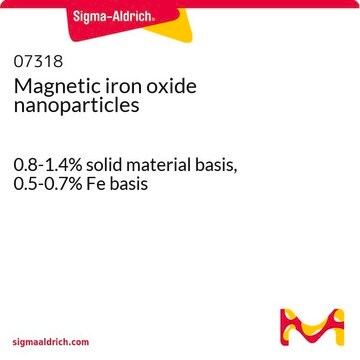310069
Iron(II,III) oxide
powder, <5 μm, 95%
Synonim(y):
Ferrosoferric oxide, Iron oxide black, Magnetite
About This Item
Polecane produkty
Próba
95%
Postać
powder
wielkość cząstki
<5 μm
mp
1538 °C (lit.)
gęstość
4.8-5.1 g/mL at 25 °C (lit.)
Zastosowanie
battery manufacturing
ciąg SMILES
O=[Fe].O=[Fe]O[Fe]=O
InChI
1S/3Fe.4O
Klucz InChI
SZVJSHCCFOBDDC-UHFFFAOYSA-N
Szukasz podobnych produktów? Odwiedź Przewodnik dotyczący porównywania produktów
Powiązane kategorie
Opis ogólny
Zastosowanie
- A starting material to synthesize Ca2Fe2O5 (srebrodolskite) microspheres via a single-stage flame spheroidisation (FS) process.
- A catalyst for reverse water gas shift reactions(RWGS).
Kod klasy składowania
11 - Combustible Solids
Klasa zagrożenia wodnego (WGK)
nwg
Temperatura zapłonu (°F)
Not applicable
Temperatura zapłonu (°C)
Not applicable
Środki ochrony indywidualnej
dust mask type N95 (US), Eyeshields, Gloves
Certyfikaty analizy (CoA)
Poszukaj Certyfikaty analizy (CoA), wpisując numer partii/serii produktów. Numery serii i partii można znaleźć na etykiecie produktu po słowach „seria” lub „partia”.
Masz już ten produkt?
Dokumenty związane z niedawno zakupionymi produktami zostały zamieszczone w Bibliotece dokumentów.
Klienci oglądali również te produkty
Produkty
Prof. Randal Lee discusses iron oxide magnetic nanospheres and nanocubes design considerations for biosensing applications.
An article concerning self-propagating reactions induced by mechanical alloying, presented by Sigma-Aldrich.com.
Magnetic materials find diverse applications from data storage to renewable energy.
Nasz zespół naukowców ma doświadczenie we wszystkich obszarach badań, w tym w naukach przyrodniczych, materiałoznawstwie, syntezie chemicznej, chromatografii, analityce i wielu innych dziedzinach.
Skontaktuj się z zespołem ds. pomocy technicznej





